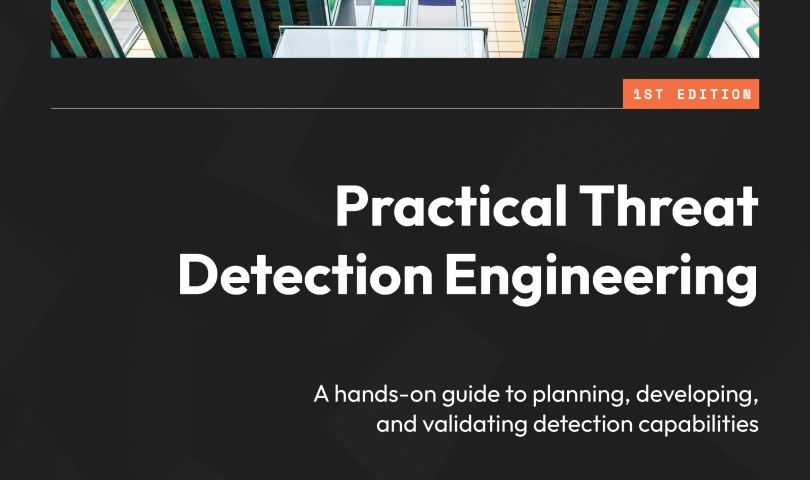Practical Threat Detection Engineering

Table of Contents
One year ago, I transitioned to the Detection Engineering team with an Incident Response background. At that moment, I began researching to learn more about the concepts I would need to tackle the challenges in my new role.
In this sense, Intelligence-Driven Incident Response (IDIR) (O'Reilly, 1st edition) was an excellent source of information, but I needed something more focused on Threat Detection. I found what I was looking for in the book Practical Threat Detection Engineering (Packt, 1st Edition) 🔗, and I decided to write a review about it.
Format and Content
This book is organized progressively. The authors start by presenting the concepts and challenges of establishing a Detection Engineering (DE) team. They then introduce concepts like the DE lifecycle, how to prioritize and write rules, how to document and test detections, and how to measure the team's performance. Chapters are divided into comprehensive parts, and at the beginning of each chapter, the authors present the main topics that will be covered, helping the reader understand what's to come.
The authors present the content in a structured way, addressing DE challenges with comprehensive solutions rather than ad-hoc fixes, making the book applicable to larger companies. It is full of good examples and exercises that invite readers to think and reflect as detection engineers. The writing style is very accessible, and even as a non-native English speaker, I could clearly understand the content without needing to look up terms or perform secondary searches.
I found great concept definitions in this book, such as the one for DE:
Detection engineering can be defined as a set of processes that enable potential threats to be detected within an environment. These processes encompass the end-to-end life cycle, from collecting detection requirements, aggregating system telemetry, and implementing and maintaining detection logic to validating program effectiveness. ... The right person needs to get the relevant information about cyberattacks in a timely fashion. This is the primary objective of detection engineering.
The book offers excellent examples of creating TTP and behavior-based detections, a goal that is often challenging to find practical materials for. It also updates concepts to align with current industry standards, such as the distinction between Detection and Hunting, Detection-as-Code (DAC), and the role of DE within the Infosec structure. Additionally, it highlights the interconnections between familiar concepts like the MITRE ATT&CK framework, the Unified Kill Chain, and the Pyramid of Pain.
Some concepts, like the DE lifecycle, make this book a valuable resource for detection engineers to consult regularly. The book's content closely relates to the daily job of a detection engineer. Unlike some books that focus solely on open-source tools and resources, this book acknowledges the use of robust closed-source tools commonly used in companies without advertising for any vendor. (They use Elastic for the lab, but they had to choose a tool for that purpose, so it's normal, in my opinion.)
Impressions
Brilliantly, the authors tie together the various concepts that encompass the area with good, realistic examples. In my experience working as a detection engineer for one year, I saw many examples that are part of my activities, and it was great to have the authors' opinions on how to tackle some problems.
For example, a few months ago, I was trying to find comprehensive categories to fit the different types of detection available. This book presents the best taxonomy for me and explains why (IOC-based, behavior-based, and TTP-based). DAC is another good example, as it's presented with real-life examples that help the reader understand how to implement it and what to expect from it.
This book will help you not only to become a better detection engineer but also to establish or revamp this area in your company. It presents a comprehensive lifecycle for detections and discusses trending topics in this area. The second part allows you to become a better detection engineer, showing how to write rules, analyze CTI reports, and better validate the rules you write. The authors finish the book by presenting metrics and strategies to help you measure your team's performance to meet your organization's needs in the threat landscape. It provides a 360º view of the Detection Engineering area.
To say that the book is not perfect, I found some issues, perhaps due to review oversights (it's OK, it's a first edition). At times, I saw the authors suggesting things like implementing a detection to replace a firewall block (prevention), which doesn't make sense to me, since we're talking about two very different controls. You can't replace one with the other, but they can certainly complement each other as they are not mutually exclusive. These are minor issues that don't affect the overall quality of the book.
Final Thoughts
This book is a must-read for Detection Engineers, especially those starting in this (relatively new) area. I saw the DE lifecycle described here fitting into the F3EAD process proposed in IDIR, with an emphasis on DE, making it a great complement to that.
In summary, I think this book is invaluable for anyone in Infosec, especially those working in Security Operations. Detection engineers, as mentioned, will greatly benefit from it, but incident responders will also learn about the challenges in writing good detections, and cyber intelligence analysts will gain insights on how to approach DE with actionable intelligence. Special kudos to Chapter 7 for having the best explanation and examples on how to write behavior and TTP-based rules.
Happy detecting!